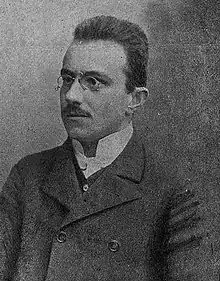Bronisław Bandrowski | |
|---|---|
 | |
| Born | 27 May 1879 |
| Died | 13 July 1914 (aged 35) |
| Nationality | Polish |
| Alma mater | Lwów University |
| Era | Contemporary philosophy |
| Region | Western philosophy |
| School | Lwów–Warsaw school Analytical philosophy |
Main interests | Philosophical logic, semiotics, experimental psychology, phenomenology |
Notable ideas | Induction, analytic methods, anti-psychologism |
Bronisław Bandrowski (27 May 1879 – 13 July 1914) was a Polish philosopher and psychologist. He was one of the pupils of Kazimierz Twardowski. Drawing from his mentor's theories and the tradition of the Lwów–Warsaw school, his works dealt with the problem of induction.[1][2] Bandrowski was also noted for his death in the Tatra Mountains near Zakopane.[3]
Background
Bandrowski was born on 27 May 1879 in Mościska (Galicia, Austria-Hungary).[2] He was the son of Alfred Bandrowski, a court clerk, and Joanna née Zajączkowska. He was also the nephew of the Polish opera tenor Aleksander Bandrowski and the cousin of the writer Juliusz Kaden-Bandrowski.
After finishing high school, Bandrowski took classical philology and philosophy at the University of Lviv.[2] He became one of the founding members of the Polish Philosophical Society and an active member and editor of the journal Ruch Filozoficzny (Philosophical Movement).[4]
Works
Bandrowski's doctoral dissertation, On methods of induction research, is considered one of his most notable works. It included a critical analysis of the intrinsic qualities of induction. In this paper, he also maintained that – to analyze induction – the question concerning the qualities of the notion of cause must first be answered.[3]
Together with Władysław Witwicki, Bandrowski developed a model of psychology based on Franz Brentano's theory on phenomenology.[5] It included an analysis of Edmund Husserl's works (e.g. theory of content and the Phenomenon of thinking). Bandrowski rejected the German philosopher's method in his embrace of the descriptive-psychological method and logical analysis.[5]
Bandrowski also authored the report containing the discussions of a 1912 Kraków congress organized by the Neurological and Psychiatric Section of the Warsaw Medical Society. The report was devoted to Sigmund Freud's concept of hysteria as well as contemporaneous issues concerning the psychoanalytical movement.[6] Bandrowski argued that there is no significant difference between the results of Freud's theory and the findings of contemporary psychological theories if his theory is formulated using the terminology of the latter.[6]
Death
In July 1914, Bandrowski went on a hiking trip in Tatra Mountains near Zakopane together with his sister and fiance Anna Hackbeilówna. The three got lost while descending Czarny Gąsienicowy Pond. Hackbeilówna fell to her death in the descent while Bandrowski and his sister got trapped on a rocky ledge called Drege's Gully.[7] Having lost hope, Bandrowski threw himself into an abyss after three days waiting for help.[3][8] His sister was later rescued by a TOPR rescue expedition led by Mariusz Zaruski.[7][9]
References
- ↑ Krajewski, Władysław (2001). Polish Philosophers of Science and Nature in the 20th Century. Amsterdam: Rodopi. p. 11. ISBN 90-420-1497-0.
- 1 2 3 Stachowski, Ryszard (1992). "Bandrowski Bronisław". In Kosnarewicz, Elwira; Rzepa, Teresa; Stachowski, Ryszard; et al. (eds.). Słownik psychologów polskich [Dictionary of Polish psychologists] (in Polish). Poznań: Instytut Psychologii UAM. p. 23. OCLC 834052536.
- 1 2 3 Brożek, Anna; Chybińska, Alicja; Jadacki, Jacek; Woleński, Jan (2015). Tradition of the Lvov-Warsaw School: Ideas and Continuations. Leiden: BRILL. pp. 265, 271. ISBN 978-90-04-31175-6.
- ↑ "Gazeta Lwowska. 1914, nr 172 – Jagiellonian Digital Library, p. 4". jbc.bj.uj.edu.pl. Archived from the original on 12 December 2019. Retrieved 15 May 2020.
- 1 2 Płotka, Witold (1 February 2020). "From psychology to phenomenology (and back again): A controversy over the method in the school of Twardowski". Phenomenology and the Cognitive Sciences. 19 (1): 141–167. doi:10.1007/s11097-019-09620-x. ISSN 1572-8676.
- 1 2 Dybel, Pawel. "The Sturm and Drang Period 1909–1914". Peter Lang. Retrieved 15 May 2020.
- 1 2 "Skrajna Sieczkowa Przełączka". malopolska.szlaki.pttk.pl (in Polish). Retrieved 15 May 2020.
- ↑ Żuławski, Wawrzyniec (1956). Tragedie tatrzańskie [Tatra tragedies]. Warsaw: Sport i Turystyka. pp. 31–32.
- ↑ Żuławski, Wawrzyniec (1956). Tragedie tatrzańskie [Tatra tragedies]. Warsaw: Sport i Turystyka. p. 35.